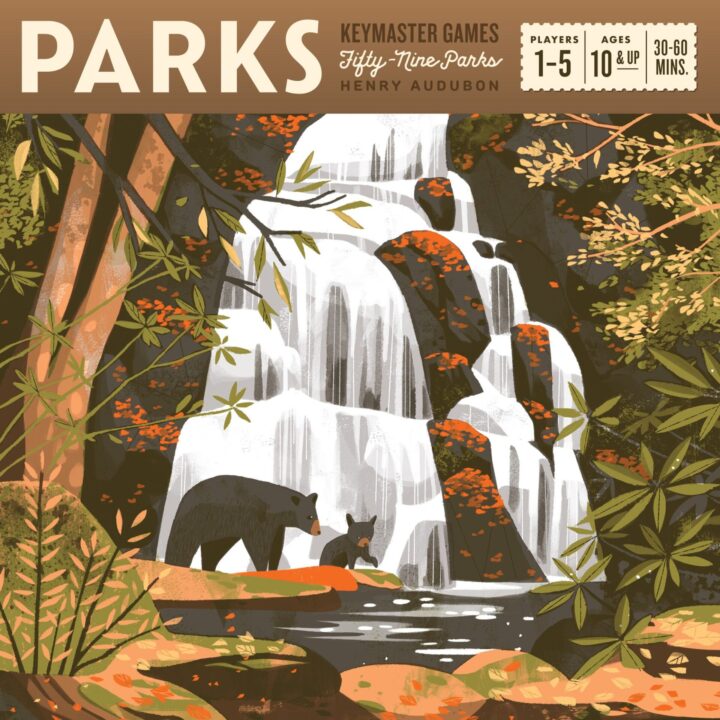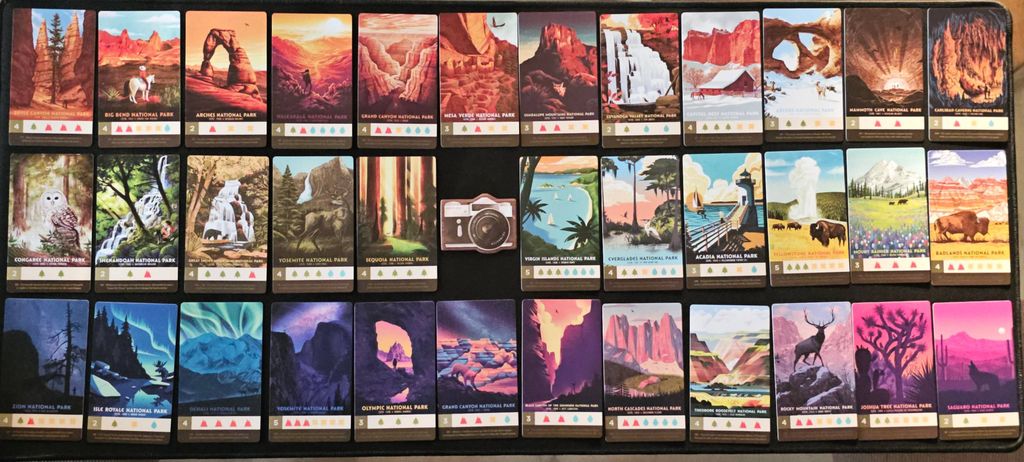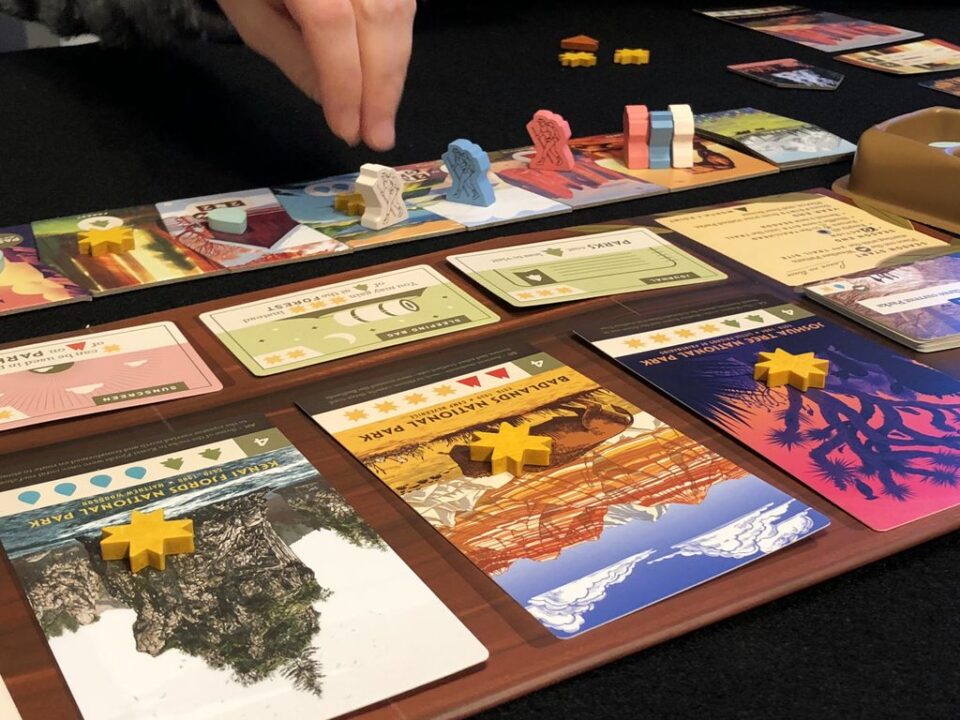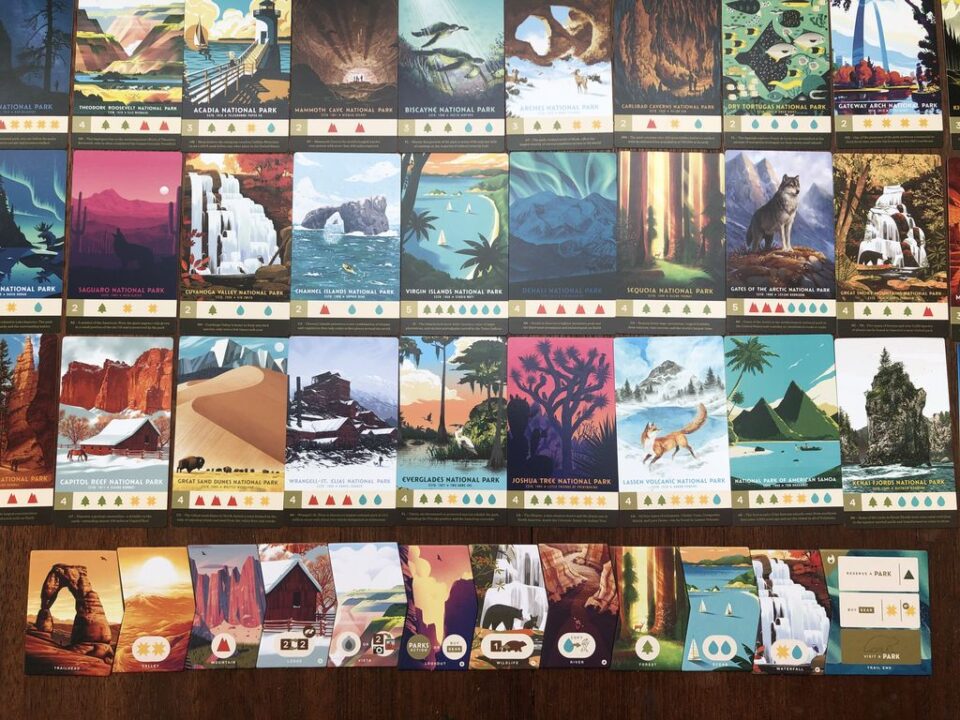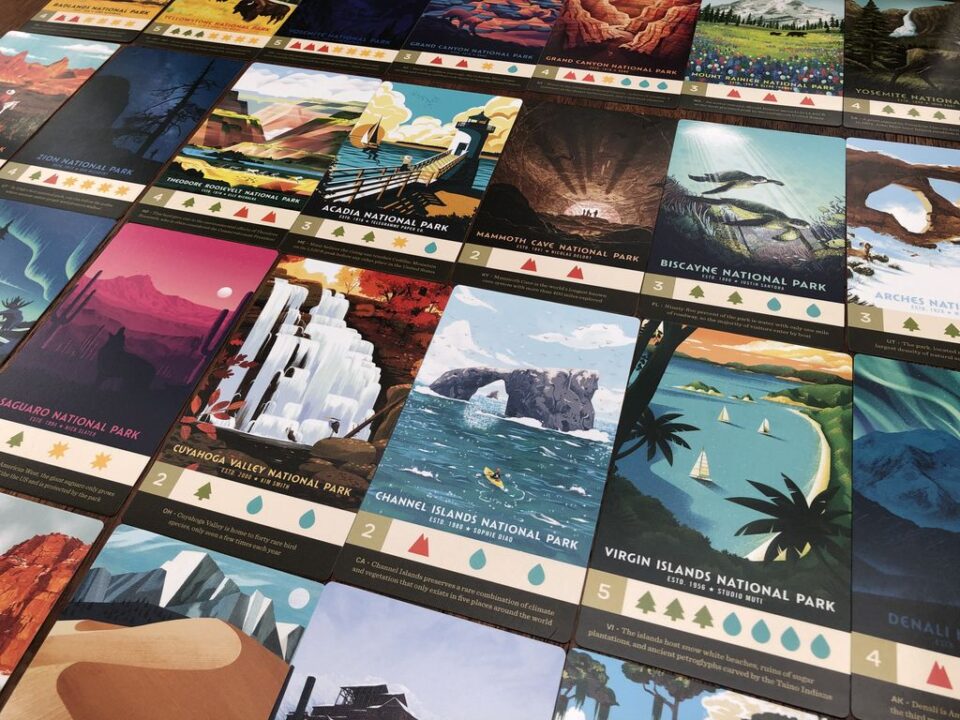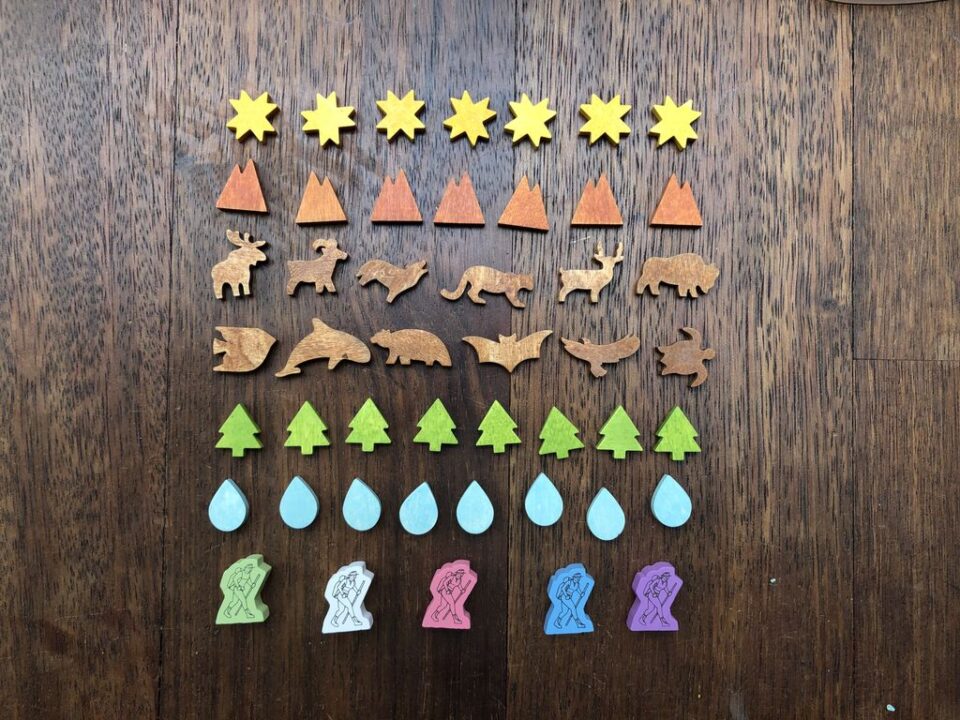If you’ve ever wanted to get the feeling of hiking through stunning landscapes without leaving your nice, safe sofa, well, boy do I have a review for you. My friends and I spent a few evenings wrestling over trail tokens and sipping lukewarm tea, all to bring you the highs and lows of this game. This isn’t just about pretty art (though, trust me, it’s got that covered), but also about how the pieces feel, how the game moves, and if luck ruins all your plans. Ready to see if you should park this one on your shelf or let it wander off? Let’s get going!
How It Plays
Setting up
Lay out the trail tiles in a row—these make your hiking path. Shuffle the park cards and gear cards, and deal each player two hikers and a canteen. Everyone gets some tokens and a campfire. The seasons and weather cards go to the side, ready to mess with your plans.
Gameplay
On your turn, pick one of your hikers and move them forward along the trail. Visit spots to gather sunshine, water, mountains, or trees. Use tokens to buy gear, fill your canteens, or snap a photo. You can only move forward, never back (just like in real life when you eat all your trail mix in the first mile). Don’t forget to claim parks before your friends do, or you might end up stuck with the birdwatching spot when you wanted the waterfall.
Winning the game
After four seasons, everyone counts their points from parks they’ve visited, photos snapped, and any bonuses from year cards. Whoever has the most points wins! If you tie, the player with the most photos takes it—so click away like a true tourist. No bear selfies, though.
Want to know more? Read our extensive strategy guide for Parks.
Stunning Artwork and Top-Notch Components in Parks
I’ll be honest – when I first saw Parks on the table, I almost mistook it for a piece of wall art. Seriously, it’s that gorgeous. My friend Dave, who usually doesn’t care about looks, even spent a suspiciously long time just examining the cards. Every park card is inspired by the Fifty-Nine Parks Print Series, which means you get a full-on art show every time you play. The colors pop, the nature vibes flow, and it sort of makes you want to go outside… until you remember bugs exist.
The wooden resources in Parks are chunky and satisfying to hold. I may have fidgeted with them way too much between turns, but who can blame me? Those water droplets are just the cutest. You also get little canteen tokens and gear cards that actually look like bits of real equipment. Even the box insert deserves an award—it fits everything perfectly, so you won’t spend hours playing ‘Tetris: The Game of Lids That Don’t Close’.
What really wowed me, though, was that everything feels solid. The trail tiles don’t warp, the cards don’t stick together, and nothing looks like it was slapped together in someone’s basement. The only real negative? The tokens are so pretty, I sometimes forget my turn just sorting them by color. Parks really set the bar high for component quality. If you want your table to look Instagram-worthy, this is the game to get.
Now, let’s see if the gameplay flow and player interaction shine as brightly as the components—or if Parks is just a pretty face!
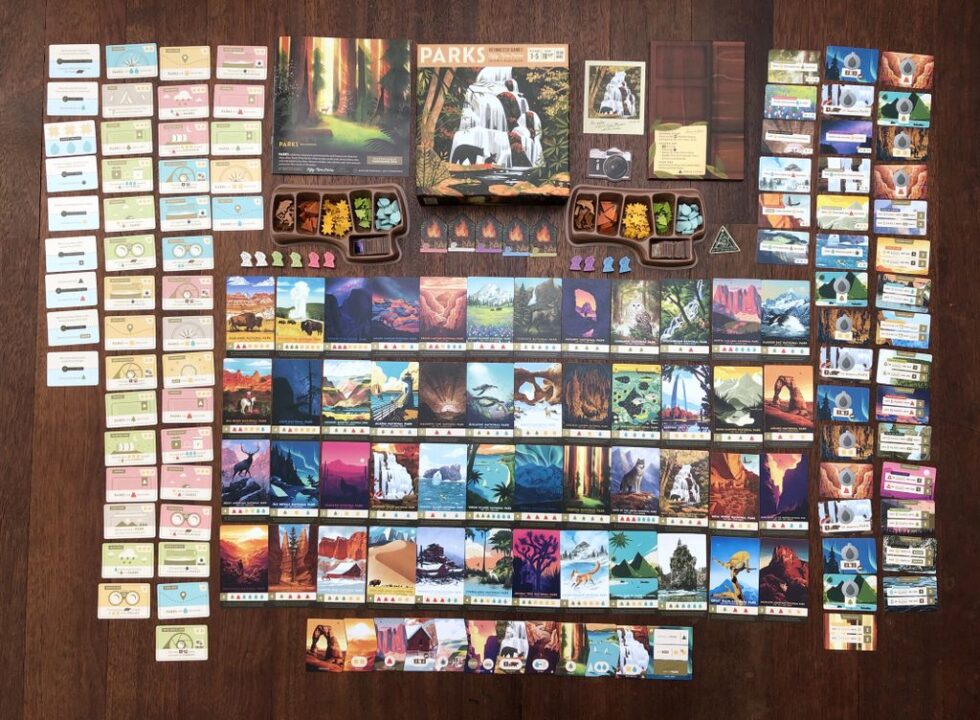
How Parks Feels to Play: Smooth Turns and Mellow Competition
Alright, let’s talk gameplay flow and player interaction. Parks runs smoother than a buttered otter on roller skates. Each player moves a pair of hikers along a gorgeous trail, stopping at spots to gather resources like sun, water, or to snap a picture. You choose when to inch forward or rush to the finish before someone else snags the best campsite. There is this sweet tension with every move because once you pass a spot, you can’t go back. I learned this the hard way after watching a friend snag a mountain token I’d been eyeing like a hungry raccoon at a picnic.
Player interaction in Parks is sneaky. It’s not in-your-face, but you sure notice when someone blocks the site you wanted. Sure, you can use your campfire to share a space once, but after that, it’s all about reading your friends’ faces—and sometimes threatening to eat all the snacks if they keep taking your photo ops. It never gets mean, though. The competition is mellow, and while you can annoy each other by beating someone to a park or gear card, you’re never out of the game. No player elimination here, thank you very much!
What I love is how Parks keeps everyone thinking, but never waiting too long. If a friend starts overthinking, just start making your best owl noises. They’ll hurry up. Next, let’s see if Parks keeps you coming back for more and what sneaky strategies might help you earn the most badges.
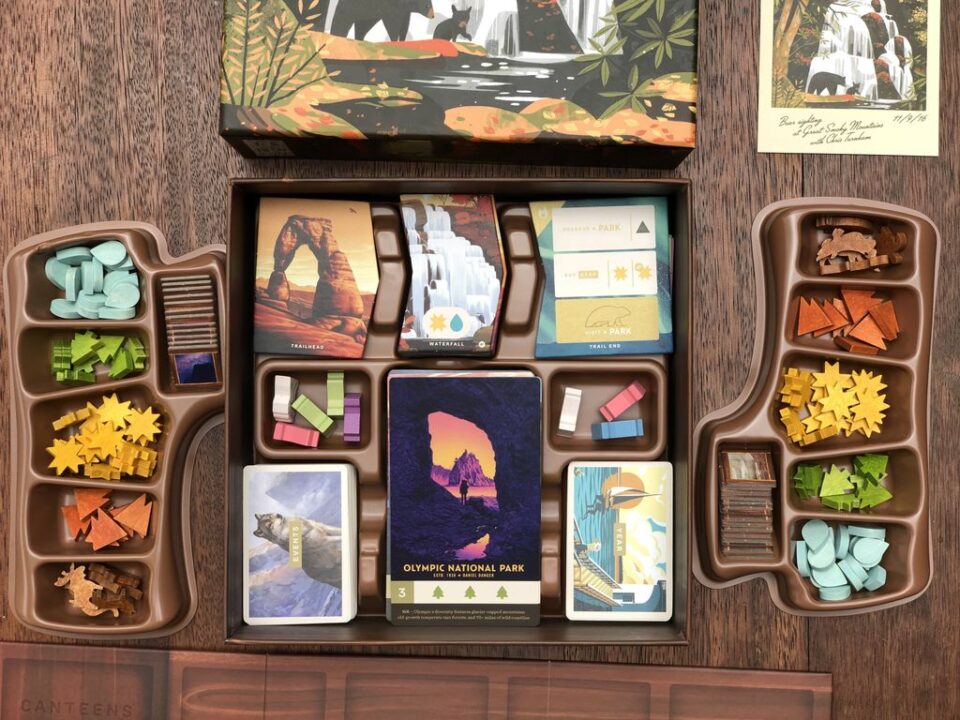
How Replayable is Parks? Let’s Talk Strategy and Long-Term Fun
I have a confession: I can’t stop setting Parks up on my table. At first, I thought it was just the pretty art (seriously, it makes my living room look fancier than it is), but there’s more to it. Parks has this sneaky replayability factor that kept me coming back, dragging my friends with me every time.
Every game of Parks throws new choices your way, thanks to the different seasons, changing weather patterns, gear cards, and the way those trail tiles get shuffled. You could play the same basic plan—say, rushing for the harder parks or hoarding canteens—and the board will always mess with your strategy a bit. Whenever I thought I had a perfect combo, someone would snatch a park right before me, or I’d realize my carefully hoarded sunshine tokens were as useful as flip-flops in a blizzard.
The best part is that Parks rewards planning. You need to think ahead, but you also have to adapt. That’s where the real strategy comes in. Hate being predictable? Try switching up your gear focus. Want to block friends (politely)? Nudge yourself just ahead on the trail. There’s not a single winning way; there are lots of little interesting decisions, so each play feels fresh. I even caught my competitive cousin secretly practicing solo. True story.
So, if you like board games that invite you to experiment and always serve up something a bit different, Parks hits that sweet spot. Now, hang on to your canteens—next, I’ll spill the beans on how much luck and skill really matter for becoming the king (or queen!) of the trails.
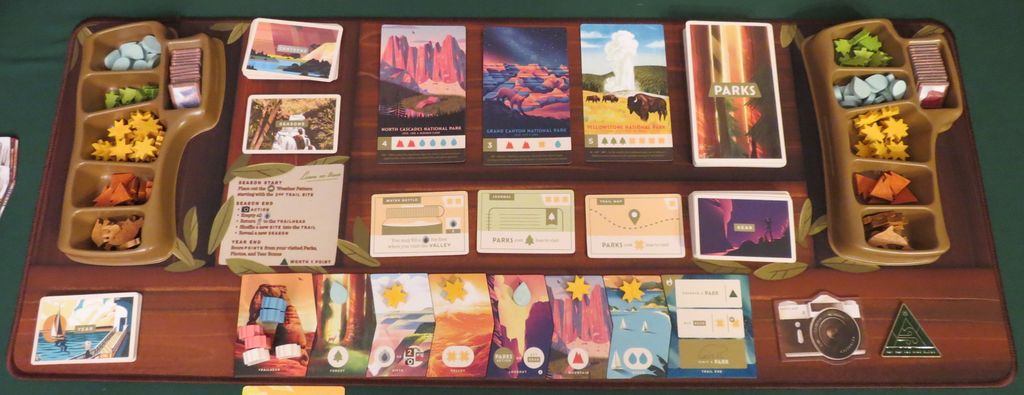
Luck vs. Skill: Who Really Decides Your Hike in Parks?
Let’s talk about the age-old board game debate: How much luck is in the mix, and how much is good, hard-earned skill? Parks does a sneaky job with this. At first glance, you might think, “Hey, this game’s chill. I’m just walking down a trail, picking up some lovely acorns and water drops.” But don’t be fooled. There’s more going on under the hood!
Skill comes into play when you plan your route on the trail. In Parks, you really want to grab certain resources and block your friends (because friendship is important, but so are park passes). If you mess up your timing, you might end up at a sad empty tile, right behind your gloating brother-in-law who just picked it clean. (Thanks, Dave.)
But luck? Oh, she’s there too, like that raccoon you can’t stop from getting into your picnic basket. The order of the trail tiles changes each round, and the season effects can throw a wrench in your plans. You never really know what bonus will pop up next. Sometimes the park cards you need just refuse to show up, no matter how hard you wish for them. And that weather pattern? Sometimes it helps, sometimes it laughs in your face.
But here’s the thing: while Parks has a sprinkle of luck, it doesn’t take over the game. If you’re clever, you can usually make something good happen. So do I recommend it? Absolutely. For fans of strategy with a dash of unpredictability, I’d say lace up your boots and take a walk in Parks!
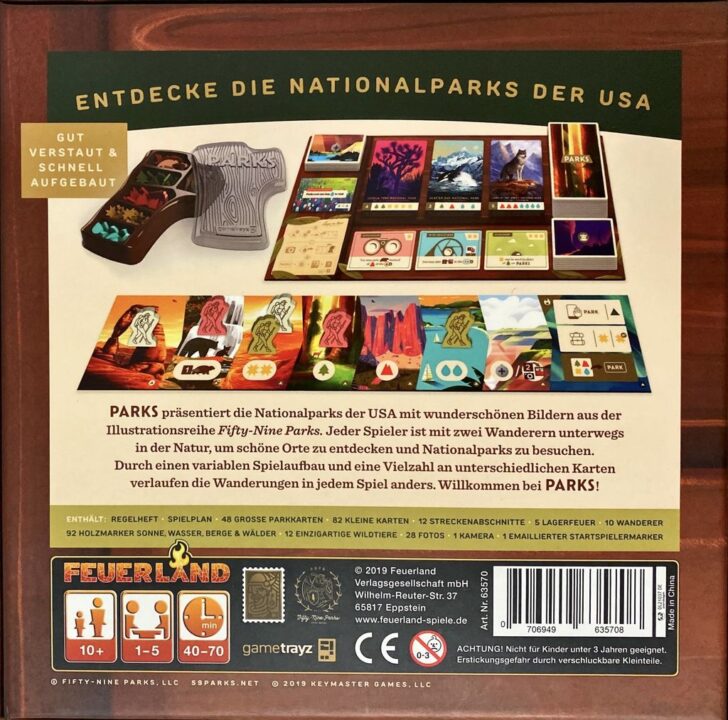
Conclusion
Parks ended up being a real gem on my table. The artwork is stunning, the wooden pieces feel great, and it’s a treat just to set it up. Gameplay is smooth and chill, with enough strategy to keep everyone on their toes, but not so much it fries your brain. There’s a bit of luck, but I never felt cheated by it. If you love beautiful board games and want something relaxing yet engaging, Parks is a safe bet. Sure, hardcore strategists might want more depth, but for most game nights, it hits the spot. Thanks for reading this review—now go hug a tree or, if you’re like me, just look at the lovely cardboard ones in the box!

